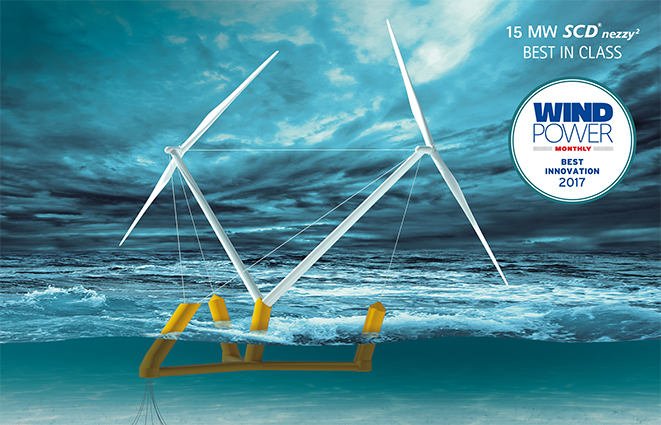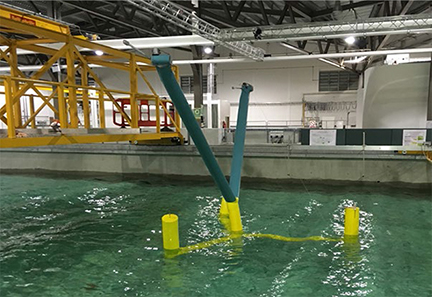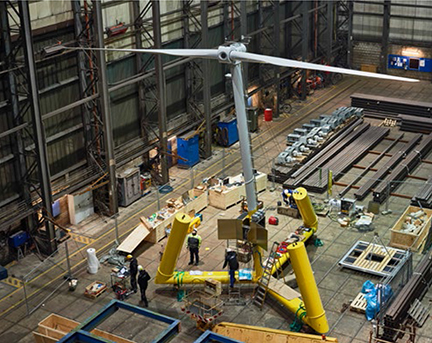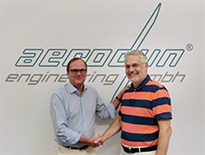| |
 |
|
 |
 |
WindPowerMonthly:
“SCD®nezzy2 provided a glimpse to offshore’s future” |
 |
 |
 |
| On 2nd January 2018 Wind Power Monthly
wrote: “The 15 MW SCDnezzy2 fully
integrated twin-rotor concept is aerodyn
engineering’s radical vision of next
generation large-scale floating power
plants. The closely interspaced two-bladed
downwind turbine counter-rotate to
balance opposing Coriolis forces, and relative
blade positions are offset by 90 degrees
to minimise rotor-blade interaction
causing tip vortices related performance
loss. SCDnezzy2 has a |
 |
specific power rating of 425 W/m2. The twin 150-meter
rotor solution lowers the centre of gravity
substantially compared to a larger
single rotor with the same specific power
rating, positively impacting floater mass
and cost.”
15 MW SCDnezzy2 overcomes the
complex handling of large wind turbines,
because large size induced the
increase in weight and hub height. The
mass moment over water line and |
 |
the lever arm affect the cost of the floating
foundation significantly. Comparing the
twin-rotor configuration of SCDnezzy2
with a single large wind turbine, when
both turbines are at the same energy
yield and technology level, then the
weight of SCDnezzy2 will be reduced
to 80 % and the hub height to 70 %
of a single large wind turbine. Both
facts lower the investment costs and
the LCoE for the twin-rotor solution of
SCDnezzy2, significantly. |
 |
|
 |
 |
|
 |
 |
 |
| New findings at the wave tank in Cork/Ireland with SCD®nezzy2 |
 |
 |
 |
Within a development time of 6 months,
we finished a first optimized geometry
for the 15 MW SCDnezzy2. Based on
that, a 1:36 model of SCDnezzy2 was
build, scaled in geometry and mass.
Two rotating beams were installed in
addition to the two thrusters at the
tower top, to simulate the mass moment
of inertia of the twin-rotor configuration,
to evaluate the dynamic
behaviour. Numerous tests were performed
under regular and irregular
wave conditions, combined with different
loads and rotating directions. The
measurement campaign assists us, to
verify our calculation models and impacts
further optimizations. The next
step will be the 1:10 open sea model of
SCDnezzy2. Therefor the design works
are mostly completed. |
 |
|
 |
 |
|
 |
 |
 |
| Final assembly of SCD®nezzy 1:10 model at Nobiskrug shipyard in Rendsburg |
 |
In summer 2017, we finished the detailed
design works for the 6 MW SCDnezzy, a
single-rotor configuration. After that we
started the design of an 1:10 open sea
model of SCDnezzy, also a single-rotor.
Parts of the requirements were, to scaled
the geometries and the masses, as well as
to use the planned materials. That’s why
the foundation was done in concrete,
the tower in steel and the guy wires in
carbon fiber. To realize the blades with
a scale weight of 1:1000 an extreme
light weight design in carbon fiber was
chosen. A weight of 26 kg for each of
the 7.3 m long blades was derived and
reached during the manufacturing. The
model provides all elements that a large
turbine systems consists of.
The entire system was assembled and
tested at Nobiskrug Werft in Rendsburg. |
 |
 |
 |
|
 |
 |
 |
The new General Data Protection Regulation GDPR will come into force on May 25, 2018
We would like to point out that we use your e-mail address and your name exclusively
for our newsletter, company information and project updates. These data will not be
forwarded or provided to third-party services or any cloud based services.
In case that you do not agree with the described use of your personal information for
data storage and our mailing list, we ask you to permanently unsubscribe from the
mailing list. Of course you will be able to change or delete your contact data at any
time in the future.
 Than please click here Than please click here
|
 |
 |
 |
|
 |
 |
 |
| Together at the Tvind turbine, now Joachim Spengler joined aerodyn as CTO |
 |
| In February 1978 Joachim Spengler and
Soenke Siegfriedsen, founder of aerodyn,
went to Denmark during the semester
break of the University of Applied
Sciences Lübeck to see the largest wind
turbine in the world at that time - the
Tvind turbine. With 54 m diameter and
2.0 MW power rating it was a monster
40 years ago. Joachim and Soenke were
so excited about it, that they decided to
focus their studies on wind energy systems.
Joachim’s thesis was about vertical
turbines and Soenke’s about |
 |
horizontal one. At that time, it was tough to get
a job in the wind energy industry, so
Joachim worked in different industries
areas (machinery, IT) and gained a lot
of experiences. Soenke founded aerodyn
in April 1983, which he has successfully
managed for 35 years. Both did not lose
contact over the years, and Joachim’s
heart continued to beat for wind energy.
Therefore, it was quite certain that Joachim
could not refuse the offer from aerodyn,
to take over the position as CTO.
We are happy to |
 |
have him on board and tare convinced that he will bring new momentum
to develop the company further.
 |
 |
|
 |
 |
|
 |
 |
 |
| Conference and Trade Fair in Hamburg |
 |
| To promote our trendsetting technology,
we will have a booth on the important
WindEnergy fair in Hamburg from |
 |
25. to 28. September 2018. We would
appreciate your visit and detailed discussions
about SCDnezzy2. |
|
 |
 |
 |
|
 |
 |
|
 |
 |
|
 |
 |
|
 |
 |
 |
You can unsubscribe this newsletter at any time here. |
 |
 |
 |
www.aerodyn-engineering.com · © aerodyn engineering gmbh |
 |
 |
|
|
|